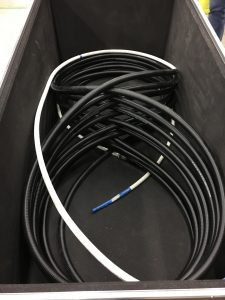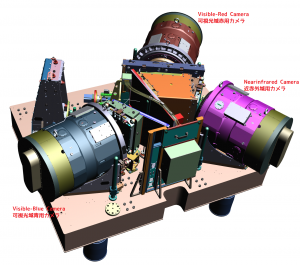In PFS observations, photons from the sky are fed into the optical fibers from one end on the Subaru prime focus, and are emitted out from the other end to feed the spectrograph. The prime focus and spectrograph are physically remote from each other, so the total length of the fibers that optically link them has to be approx. 60 meters. For this application, the fibers are integrated into a cable as shown below. A major length, about 50-meters, of the cable will be routed on the telescope and inside the telescope enclosure building. A prototype of this 50-meter cable has been in under construction for the last two months at PPC Broadband Fiber in the UK, and is now near completion.
The actual science fiber cables will be permanently installed on the telescope and in the enclosure building for more than 10 years while PFS is in operation. This means that the cable will need to maintain good performance for a long period of time under regular working conditions, very dissimilar to a highly controlled laboratory situation. The structure of the cable has therefore been designed to be an analog of an optical communication cable that needs to meet similar requirements: The fibers are distributed into segmented polymer tubes (Figure 1) and these tubes are stranded around a central strength member (Video 1). In this way, any tensile stress experienced by the cable is carried by the strength member, not the fibers. This stranded assembly is then wrapped by a vinyl tape and is inserted into a PVC-coated flexible metal conduit (Figure 2). The conduit protects the cable against radial stresses (crushing forces) and the risk of environmental contamination such as water or oil leaks.

Figure 1: Bare fibers protruding from a segmented tube.
Video 1: This shows segmented tubes getting stranded around a strength member.
The next step is that this prototype cable will be finalized by terminating and capping to protect both ends. The optical performance of the fibers inside will then be measured. After this process the cable will be shipped to Subaru Telescope, where further optical tests will be performed with the cable whilst routed on the telescope in a similar way, to characterize the optical performance for varying telescope elevation angles.

Figure 2: This indicates the current status of the prototype cable: The stranded assembly has been pulled into the PVC-coated metal conduit and is stored in a shipping container.



